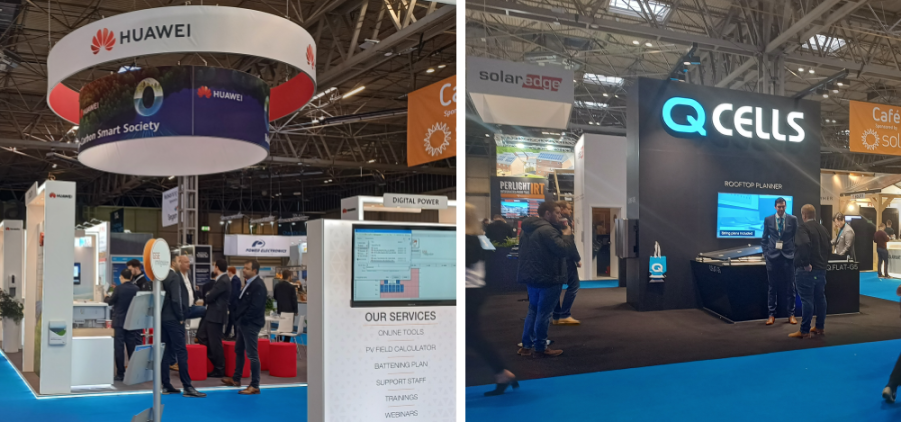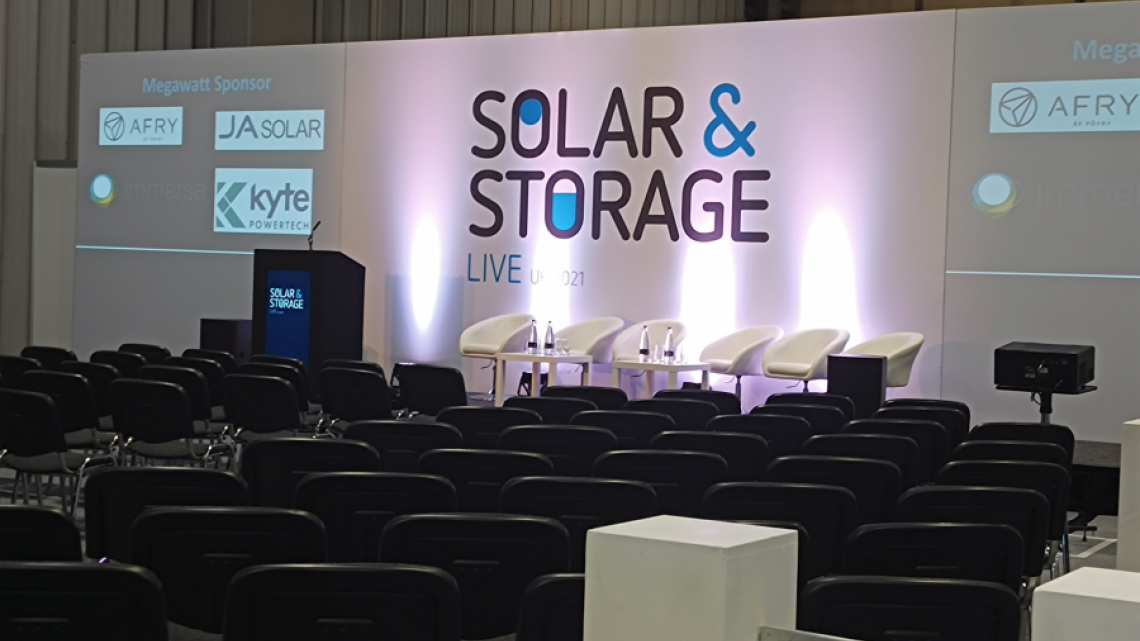Solar & Storage Live took place at the NEC in Birmingham between 23-25 November 2021. Image: Solar Power Portal
For many of those attending last week’s Solar & Storage Live in Birmingham’s NEC, it was the first opportunity in eighteen months to see faces both new and old, drink questionable conference hall coffee and get back up to speed on all things energy.
It made for an energetic atmosphere in the brightly lit conference hall (3A, for those interested), which was packed full of the biggest players in the UK solar market - as well as some fresh new entrants and start-ups. Walking through, it was impossible to miss the towering stands of the likes of Solar Energy UK, Q CELLS, Huawei, Voltalia, SolarEdge and many others, while the start-up zone saw firms such as VEST Energy, Cheesecake Energy, UrbanChain and Gravitricity exhibit - the latter of which lauded its gravity-based energy storage solution, which managing director Charlie Blair said achieves very fast reaction times and high durability.

Huawei, Q CELLS and SolarEdge all featured prominent branding. Image: Solar Power Portal
The mood was bright, and all those spoken to by Solar Power Portal during the event talked of the enthusiasm, resiliency and (very welcome) activity and demand within the sector. It was a theme that carried through the conference, started by Solar Energy UK’s chief executive Chris Hewett who referenced the confidence and determination he’d seen from the industry during COP26, and gave his own confident statement that Solar Energy UK’s 40GW by 2030 goal – which the trade body has been campaigning to be adopted by the government – is not only achievable, but potentially beatable too.
Indeed, stood on stage at a packed keynote theatre on day one of Solar & Storage Live, Hewett said: “The next decade is going to be absolutely huge for the industry.”
And it certainly seemed that this was a much-agreed upon statement, although this is probably no surprise considering the net zero trajectory the world is on. Segen’s sales and marketing director Liz MacFarlane told Solar Power Portal of the company’s surging demand, with the residential business twice as large as it was this time last year. In particular, demand for higher efficiency modules has gone up, with this enabling PV to be fitted even on smaller roofs, which MacFarlane said is making commercial schemes much more viable.
Across the five theatres, audiences benefited from insight on subjects ranging from how to maximise battery storage revenues to support mechanisms for solar such as the Contracts for Difference (CfD) scheme to how to scale up community energy.
Panellists in the latter of those spoke of the benefits of large solar developers bringing community energy organisations into their developments, with community energy organisations able to act as intermediaries between large developers and the local community as well as being able to provide finance.
Meanwhile, talk of the CfD – a major sticking point for the industry since solar was barred from the auctions – could probably be summarised as a support mechanism that’s nice to have, but with subsidy-free solar now viable, not necessary for projects to come to fruition. However, James Armstrong, managing partner of Bluefield Partners, said during a panel session on the subject that the CfD is still likely to attract a lot of interest due to the security of income it provides, which he described as highly attractive.

James Armstrong, managing partner of Bluefield Partners, spoke on the CfD alongside Jonathan Selwyn, managing director of Bluefield Development, Cameron Witten, head of policy at Solar Energy UK and Nick Blair, head of scheme management at the Low Carbon Contracts Company Ltd. Image: Solar Power Portal
There was also much talk of – and both panel sessions and presentations on – electric vehicle (EV) charging, reflecting its growing presence in the energy industry as well as how it is increasingly interacting with solar and battery storage, both on larger scales such as solar-powered EV charging hubs and on a residential and commercial scale, where EV charging, solar and battery storage can combine in a home to maximise the use of each.
Talk did, too, turn to the high power prices seen across Europe currently, which while certainly beneficial to some operating in the solar and battery storage space, have also had negative impacts, particularly on the energy supplier market, with 27 supplier exits from the British energy market this year. This was referenced in some of the conversations and presentations across the three-day event, with Josh King, operations director of AES Solar, referencing the difficulty in updating his presentation on the Smart Export Guarantee (SEG) rates offered by suppliers as more continue to go out of business.
Indeed, Bulb – which offered one of the highest SEG rates of 5.38p/kWh – went under so close to the conference, it still formed part of the graphs on show, which detailed how there is still a competitive marketplace in place for the SEG, with residential rooftop PV “on the up”. Elsewhere, exhibitors spoke of the difficulty in launching new domestic products such as home energy management solutions in partnership with energy suppliers in the current state of the market.
But still, the overall message to come out of Solar & Storage Live 2021 was a genuine happiness to be back in a room together, seeing the newest tech, companies and predictions for the future of the industry, forming new deals – with Solar Energy UK announcing a new affiliate membership in partnership with the MCS at the trade show – and catching up with old friends and colleagues. Even if it was over conference hall coffee.

